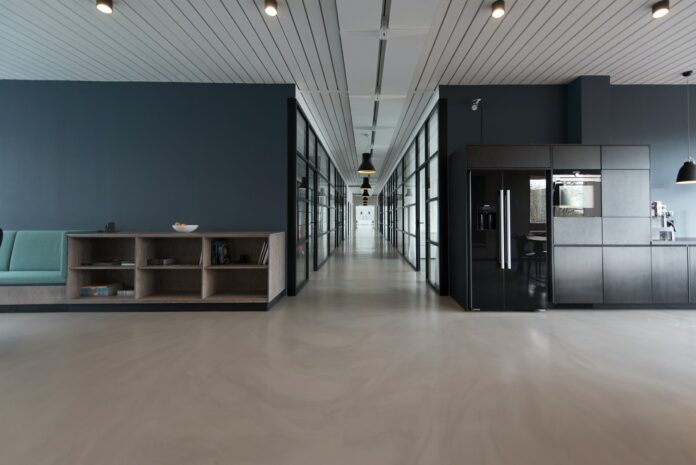Remote work has become part of their daily routine for many employees in the past twenty months. After a period of adaptation, most of them have found a new appreciation for this lifestyle that allows them a better work-life balance and flexibility. For example, the absence of lengthy and expensive commutes has allowed them to spend more time with their families and friends and take care of themselves.
On the other hand, employers and developers are struggling with the implications. The formers lament the lack of cooperation, spontaneous creativity, and decline in company culture. However, productivity appears to remain stable thanks to the development of tools like Zoom, Slack, or DocuSign during the pandemic. For office building owners, the implications are even more far-reaching. Their properties stand largely empty, rent unpaid, leaving them to consider alternative ways – such as turning vacant offices into sorely needed affordable housing – to repurpose the edifices.
Such adaptive reuse is not always financially and structurally possible. Turning cubicles and meeting rooms with little access to natural light into desirable apartments requires significant investments and lengthy construction to modify the core of the property, not to mention convoluted negotiations with city planning boards to obtain the necessary zoning variances.
Therefore, it is up to company owners and property developers to work hand-in-hand to lure employees back to the office. But how can they convince office workers to return to their cubicles in a world full of uncertainties?
The great divide between employers and employees
The COVID-19 pandemic took the world by surprise. Within days, companies and employees scrambled to find solutions to keep business going as they switched their full-time office job for remote work. The return-to-work date has been a moving target ever since. The appearance of the Omicron variant is once again pushing companies’ plans to bring workers back to the office further into the future, at least until the New Year.
However, there is another factor to consider beyond companies’ agendas. New routines and new tools have rapidly overtaken the way we work, and employees have found a new appreciation for this lifestyle which gives them a tremendous amount of freedom as to when and where they work. Flexibility has become one of their priorities when deciding on their career choices, to the point where many would happily trade for a new job if their employer were to take the option to work remotely, at least for part of the time.
It may come as a shock for executive-level employees. According to a recent Future Forum Pulse survey, nearly half of all executives surveyed (44%) want to work from the office every day, compared to 17% of employees (2.6x difference.) Besides, most executives (66%) report designing post-pandemic workforce policies with little to no direct input from employees. Such a strategy is a dangerous bet as more than half of knowledge workers—57%—are open to looking for a new job in the next year. In other words, if companies want to bring workers back to the office, it would be best to find ways to seduce them rather than force them back into their old ways.
Luxury amenities in office buildings
Commercial real estate has greatly suffered from the pandemic. Widespread remote work, even part-time, would significantly reduce the need for companies to maintain large and permanent office spaces. Several employees could share the same workstation on rotating days, for example. Freelancers, startups, and smaller businesses could also sublease meeting rooms and offices from larger corporations to create additional revenues and maximize occupancy. However, property developers are also exploring another option: turning office buildings into a space where workers want to be rather than somewhere they have to be.
To do so, they must take into consideration employees’ aspirations and comfort. Health concerns remain a significant obstacle for workers to make their way back to the office. Between commuting via public transportation and days spent in shared areas with poor ventilation, the fear of contagion constitutes a significant impediment. Office developers can alleviate some of these fears by instating strict sanitary policies and installing upgraded ventilation systems or air purifiers, physically distanced workstations, touchless equipment, sanitation procedures and self-cleaning surfaces, and weekly deep cleaning.
A new generation of office buildings is also making an apparition, providing a comfortable and desirable alternative to a loud and cramped home office. One Vanderbilt, a new 93-story skyscraper recently completed near Manhattan’s Grand Central Terminal, constitutes a real experiment in what post-pandemic office buildings could be.
The property was designed to make employees feel welcome, combining quiet areas providing a “library-like atmosphere” with open spaces designed to entertain the tenants and their guests. Around the country, office developers are including access to green spaces and roof terraces rather than maximizing rental space with large floor plates and little natural light. With new physical layouts, luxury amenities such as restaurants managed by Michelin-starred chefs, enhanced technology, and areas dedicated to entertainment, the office of the future is a far cry from your 2019 dark cubicle.
Employees as part of the solution
The COVID-19 pandemic has dramatically changed the way we live and work. Many workers have reconsidered their priorities, leading to career changes and cross-country moves. If companies want to retain their employees, they must include them in the discussion as to what their future should look like.
After graduating with a Master’s degree in marketing from Sciences Po Paris and a career as a real estate appraiser, Alix Barnaud renewed her lifelong passion for writing. She is a content writer and copywriter specializing in real estate and finds endless fascination in the connection between real estate, economic trends, and social changes. In her free time, she enjoys hiking, yoga, and traveling.



